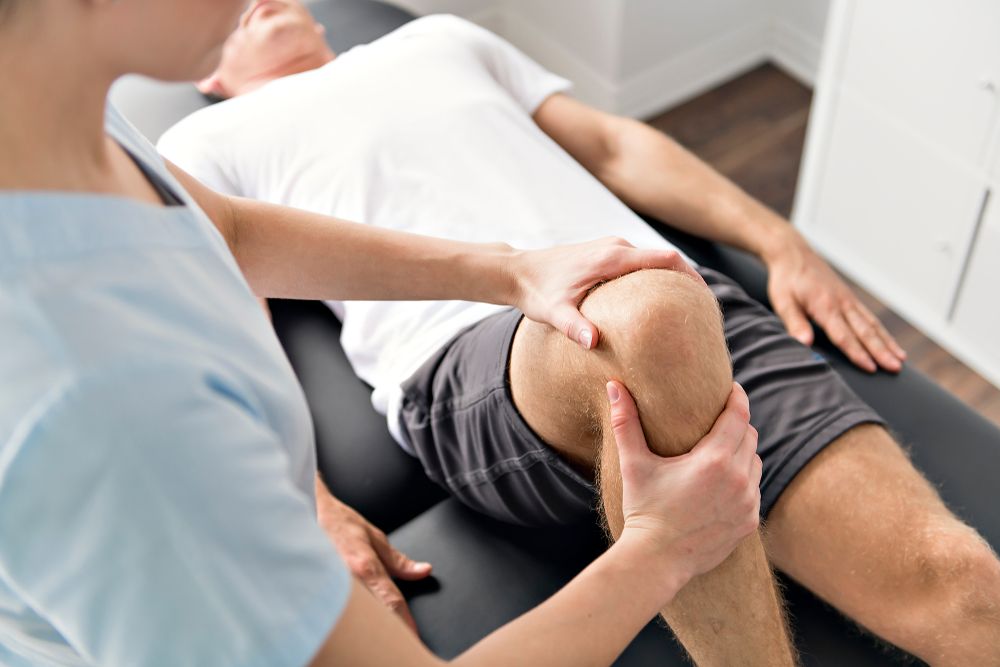What is arthritis?
Arthritis is where the smooth gliding cartilage (articular cartilage) wears away. As the arthritis becomes more advanced, portions can wear completely away until the underlying bone is exposed. Based on what part of your knee wears out first, some patients can have an obvious deformity where they are very “bowlegged” or ”knock kneed”.
Will surgery correct this?
Yes. By carefully removing specific amounts of bone, your surgeon will be able to realign your knee to reestablish a more normal alignment.
What happens during surgery?
Your surgeon will use specially designed instruments to carefully remove the arthritic cartilage and damaged bone from your femur (thigh bone), tibia (shin bone), and patella (knee cap). The end of the femur and tibia are replaced with metal and the gliding surface of the patella is replaced with plastic. Then after a perfect fit is insured, the implants are cemented in place. Then a plastic spacer is placed between the metal implants. Then you wake up in the recovery room.
How long does surgery take and how long while I be in the recovery room?
Typically, the surgery takes 2 hours and most people during the recovery room for about 60-90 min.
What type of anesthesia is used?
A combination of general anesthesia as well as a regional anesthetic (nerve blocks) are used. The nerve blocks typically help with pain relief for up to 24 hours after surgery. Your surgeon will also inject long-acting numbing medicine in your knee that can last up to 72 hours. Your anesthesiologist will discuss all the different options with you on the day of your surgery.
How long will I be in the hospital?
With the advances made in pain control, the majority of people will go home the same day that they have the surgery. If medically needed, you may spend the night in the hospital and go home the following day. We will keep you in the hospital as long as necessary, but remember that hospitals are full of sick people and the person in the room next to yours may be there for a skin infection, pneumonia, etc. So, everyone involved in your care is motivated to get you home as quickly and safely as possible.
What should I expect in the hospital?
This will be addressed in detail at the preoperative total joint teaching classes offered by Meridian Park hospital and Willamette Falls hospital. (During the pandemic, the hospital will send this information to you rather than have an in person class)
How quickly will I walk after surgery?
Your physical therapist will get you out of bed the day of your surgery (unless it is very late in the afternoon) to try walking right away and they see you twice a day while in the hospital. An occupational therapist will also see you to help make sure you can safely perform activities of daily living such as dressing, showering, et cetera.
Will I have to have a catheter in my bladder?
No. These are only used if you cannot urinate on your own.
Will I need a blood transfusion?
It is very rare to require a blood transfusion after the surgery.
When can I take a shower?
Most people shower one or 2 days after surgery. You will have a special waterproof dressing on your knee after surgery.
Do I need to change the dressing after surgery?
You will receive detailed discharge instructions when you leave the hospital. We use a waterproof surgical dressing that will stay on your knee for one –two weeks after your surgery. Then you will remove it and as long as your incision is clean and dry, you did not have to have a surgical dressing over it.
What type of pain medicine will like be on after surgery?
We used several different medications to help control pain after surgery. This way we are controlling pain through several different pathways. Each medicine works on a different part of your brain/spinal cord to prevent pain. As your pain is improving over the days/weeks after surgery, you will decrease the amount and frequency of your pain medicines. The following is a list of several different medications you may be on:
- Narcotics-you are typically on a short acting narcotic such as oxycodone (Percocet), or hydrocodone (Vicodin or Norco). The doses vary based on factors such as your age, weight, etc.
- Acetaminophen (Tylenol)- this is also used as a pain reliever after surgery, unless it is already mixed in as part of your narcotic in medicines such as Vicodin or Norco.
- Over-the-counter anti-inflammatory medicines-these are typically used once you have finished your blood thinner.
What other medicines will be sent home on?
- Antinausea medicine-typically a prescription for promethazine (Phenergan) or ondansetron (Zofran) is given for convenience. We recommend you fill it but you only need to take it if you are having nausea. Taking your pain medicine with food will help prevent nausea.
When can I stop my pain medicine? How do I taper off of it?
You can stop your pain medicine as soon as to feel comfortable doing so. Your narcotic pain medicine will likely say to “take 1 or 2 pills every 3 hours as needed for pain”. If you are taking 2 pills, as your pain is decreasing you can switch to 1 pill, or increase the amount of time between doses to 4 hours, 5 hours, etc. based on your comfort level. Eventually, you will wean completely off of the medicine. As for gabapentin which is every 12 hours, people typically stop the daytime dose first, then take it only at night for a couple of days. You may also wean off of your anti-inflammatory medicine and/or Tylenol as needed.
What type of blood thinner will I be on after surgery?
Depending on your health, we may use aspirin 81mg twice a day for one month. Or if you are at higher risk of having a clot, we can use an oral blood thinner such as Xarelto for 12 days. After you finish this, we typically have you use an aspirin (81mg) twice a day for 2 weeks, or resume your regular aspirin dose if you normally take aspirin.
What other methods are used to prevent blood clots after surgery?
- Early ambulation-we want you up and walking at least 3 times a day. Some people wonder how much walking is too much walking… Your body will tell you. If you’re knee is extra painful or swollen, then you are walking too much.
- TED hose-these are tight white compression socks, typically knee-high, that we have you wear 23 hours a day to prevent blood clots. These are used for 2 weeks after surgery.
- Sequential compression devices (SCDs)-these are used at home as well as in the hospital to help prevent blood clots. They wrap around your lower leg and will intermittently gently squeeze your calf muscle to help prevent blood clots. You will use these whenever you are sitting or laying down, including sleep. You may remove them when you are walking or exercising. These are used for 2 weeks after surgery.
When will I start physical therapy?
You will normally start outpatient physical therapy about 4 days after your surgery. If you are not strong enough, or your support system cannot get you to an outpatient physical therapist easily within the first 2 weeks after surgery, home health physical therapy can be arranged. However, our preference is to start outpatient physical therapy as soon as possible. We typically see much more improvement with outpatient physical therapy than with home health therapy.
What special equipment will I need after surgery?
Our surgery scheduler will arrange for the SCD machine to be available. They will also arrange for a walker if you don’t have one. Also, if you are interested in a cooling unit, rather than using ice bags or frozen gel pads, contact our office and we sell these. Finally, some people like to use a shower chair, elevated toilet seat, or bedside commode. These can be purchased at a local medical supply store.
When can I drive after surgery?
It takes most people about 3 weeks before they are able to drive after surgery. You need to be off of the narcotic pain medicine during the time you would be driving and be able to safely move your operative leg quickly enough to operate your vehicle.
When can I return to work?
This depends on your profession. If you have a sedentary desk job, you should be able to return in 4 weeks. If you have a more physical job or one that requires you to stand all day long, it could be as long as 6-12 weeks before you could return.
How often will have follow up visits with the surgeon?
We typically see you at 2 weeks after surgery, 6 weeks after surgery and at 12 weeks after surgery. If everything is going well at that point, then we typically don’t see you back until your one year anniversary from surgery. Obviously if there are any concerns, we will see you more frequently.
What type of exercise can I expect return to after surgery?
Generally speaking, people are able to return to low impact activities such as walking, dancing, golf, hiking, swimming, bowling, gardening, and doubles tennis. Some people are also able to return to more aggressive activities such as skiing, but on groomed surfaces only.
Do I need to let my dentist know I had a knee replacement?
Yes! Typically, after a joint replacement surgery, patients need to be on antibiotics before they have any dental procedure, including a routine cleaning for the first two years after surgery. Call our office or your dentist several days before your dental appointment and we can call in a prescription for antibiotics that you will take 1 hour prior to your appointment.
What up out when I go through the security checkpoint at the airport? Will I set off the metal detector?
Yes. You will likely set off the metal detector. Some of the joint replacement manufacturers will provide you with a card that shows you have metal implanted in your body but it will not get you through security any faster. I typically tell patients to get there 5 min. earlier than you would normally arrive and wear baggy pants so you can show the TSA agents the cool scar on your knee.
My new knee makes a clicking sound when I walk. This is normal?
Yes. Some people experience a clicking sensation when they walk because they now have metal that glides on plastic as their new joint surface.
How long will my knee be swollen after surgery?
Swelling can take 6-12 months to resolve after surgery.
At times my knee is achy after surgery, this is normal?
Yes, occasional achy pain and swelling can be experienced for up to 12 months after surgery.

